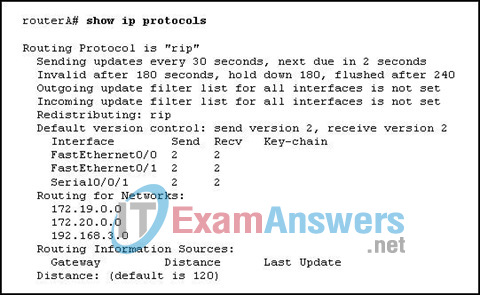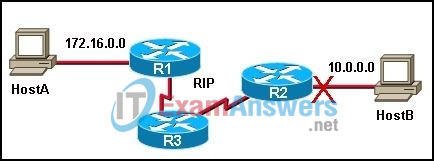1. Refer to the exhibit. Which configuration command or commands contributed to the output that is shown?

- routerA(config-router)# no version 2
- routerA(config)# interface fa0/0
- routerA(config-if)# ip address 172.19.0.0 255.255.0.0
- routerA(config-router)# network 192.168.3.0
- routerA(config)# no ip default-gateway
2. Refer to the exhibit. What is the maximum number of RIP routers that could separate HostA and HostB and still leave the hosts with connectivity to each other?

- 14
- 15
- 16
- 17
3. In which situation would a company register for its own autonomous system number (ASN)?
- when the company’s ISP adds connection points to the Internet
- when additional routers are added to the corporate internetwork
- when more than one interior routing protocol is used
- when the company uses two or more ISPs
4. Consider this routing table entry
R 172.16.1.0/24 [120/1] via 200.1.1.1 00:00:27 Serial0/1
What type of route is this?
- a static route
- a default route
- a RIP route
- an OSPF route
- an EIGRP route
- a directly-connected route
5. What is the difference between interior and exterior routing protocols?
- Exterior routing protocols are only used by large ISPs. Interior routing protocols are used by small ISPs.
- Interior routing protocols are used to route on the Internet. Exterior routing protocols are used inside organizations.
- Exterior routing protocols are used to administer a single autonomous system. Interior routing protocols are used to administer several domains.
- Interior routing protocols are used to communicate within a single autonomous system. Exterior routing protocols are used to communicate between multiple autonomous systems.
6. What information is included in RIPv2 routing updates that is not included in RIPv1 updates?
- metric
- subnet mask
- area identification
- hop count
- autonomous system number
7. Which routing protocol is used to exchange data between two different ISPs?
- BGP
- EIGRP
- OSPF
- RIP v2
8. Which command is used to view the RIP routing protocol settings and configuration?
- show version
- show ip route
- show interface
- show ip protocols
9. Refer to the exhibit. If all routers are running RIP and network 10.0.0.0 goes down, when will R3 learn that the network is no longer available?

- in 30 seconds
- in 60 seconds
- in 90 seconds
- Immediately
10. What statement is true regarding an AS number?
- AS numbers are controlled and registered for Internet use.
- Interior routing protocols require registered AS numbers.
- ISPs require all customers to have registered AS numbers.
- All routers at an ISP must be assigned the same AS number.
11. What is the purpose of the network command used when configuring RIP?
- to specify whether RIPv1 or RIPv2 will be used as the routing protocol
- to allow the router to monitor RIP updates that occur on other routers
- to identify which networks on the router will send and receive RIP updates
- to configure the IP address on an interface that will use RIP
- to identify all of the remote networks that should be reachable from the router
12. Which command would a network administrator use to determine if the routers in an enterprise have learned about a newly added network?
- router# show ip address
- router# show ip route
- router# show ip networks
- router# show ip interface brief
- router# debug ip protocol
- router# debug rip update
13. What is the purpose of a routing protocol?
- It is used to build and maintain ARP tables.
- It provides a method for segmenting and reassembling data packets.
- It allows an administrator to devise an addressing scheme for the network.
- It allows a router to share information about known networks with other routers.
- It provides a procedure for encoding and decoding data into bits for packet forwarding.
14. What device enables an ISP to connect with other ISPs to transfer data?
- border gateway router
- DSLAM
- web server
- interior router
15. Which command will display RIP routing updates as they are sent and received?
- show ip route
- show ip rip
- debug ip rip
- show ip protocols
- show ip rip database
16. Which part of an IP packet does the router use to make routing decisions?
- source IP address
- source MAC address
- destination IP address
- destination MAC address
17. What two types of businesses would benefit from registering as their own autonomous systems? (Choose two.)
- a home business with one ISP connection
- a global business with connections to multiple local ISPs
- a medium-sized nationwide business with Internet connectivity through different ISPs
- a large enterprise with two connections to the same ISP
- a small ISP with a single Internet connection through a larger ISP
18. Which command will display RIP activity as it occurs on a router?
- debug ip rip
- show ip route
- show ip interface
- show ip protocols
- debug ip rip config
- show ip rip database
19. Why is fast convergence desirable in networks that use dynamic routing protocols?
- Routers will not allow packets to be forwarded until the network has converged.
- Hosts are unable to access their gateway until the network has converged.
- Routers may make incorrect forwarding decisions until the network has converged.
- Routers will not allow configuration changes to be made until the network has converged.
20. Which two statements describe static routes? (Choose two.)
- They are created in interface configuration mode.
- They require manual reconfiguration to accommodate network changes.
- They automatically become the default gateway of the router.
- They are identified in the routing table with the prefix S
- They are automatically updated whenever an interface is reconfigured or shutdown.
21. Which two statements or sets of statements describe differences between link-state and distance vector routing protocols? (Choose two.)
- Link-state routing protocols routinely use more bandwidth for updates than do distance vector routing protocols.
- Distance vector routing protocols update all routers at one time. Link-state routing protocols update one router at a time.
- Link-state routers only know about directly connected routers. Distance vector routers know about every router in the network.
- Link-state routing protocols update when a change is made. A network using distance vector routing protocols only updates at a specific interval.
- Distance vector routing protocols have limited information about the entire network. Link state routing protocols know about all routers in the network.
- In case of similar topologies, networks using link-state routing protocols typically converge more rapidly than do networks using distance vector routing protocols.
22. Which protocol is an exterior routing protocol?
- BGP
- EIGRP
- OSPF
- RIP
23. Hosts on two separate subnets cannot communicate. The network administrator suspects a missing route in one of the routing tables. Which three commands can be used to help troubleshoot Layer 3 connectivity issues? (Choose three.)
- Ping
- show arp
- Traceroute
- show ip route
- show interface
- show cdp neighbor detail
24. What term refers to a group of networks that uses the same internal routing policies and is controlled by a single administrative authority?
- Internet
- intranet
- virtual private network
- autonomous system

A new junior network intern connects a laptop to an access layer switch in the wiring closet. After configuring a terminal emulation program, the intern presses the Enter key, and the S1_ATC_E2> prompt appears. What could have been done to better protect the switch?
Create a banner message.
Create a console password.
Use the enable secret command.
Use the service password-encryption command.